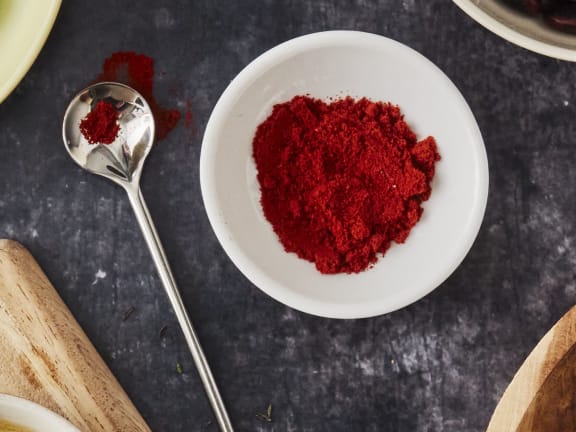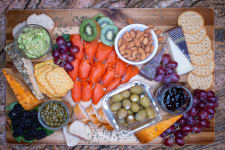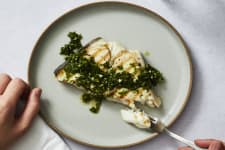Spring cleaning is an opportunity for you to let in some light and air, to refresh your home and routine so that you’re ready to flourish in the brightening days. For home cooks, one area to focus your spring cleaning energy on is the pantry. Whether you’re discarding stale items or restocking with the pantry with some essentials, a pantry refresh will help set you up to cook delicious, easy seafood meals throughout the year.
Here are six shelf-stable pantry items that every seafood lover should have in their kitchen:
The one spice you need:
Spanish paprika

Use Spanish paprika to:
-
Enhance everything from spice blends to stews with smoky, umami flavors
-
Add appetizing color to seafood when using high heat cooking methods
Made from peppers that have been smoked over aromatic hardwoods, Spanish paprika (otherwise known as pimenton or smoked paprika) has a robust, umami-rich flavor profile, bolder than the paprika that many of us are familiar with. Rich and smoky, Spanish paprika adds savory umami to your seafood meals. It also browns readily when cooked with high heat, so it’ll add mouthwatering color to any seafood that you’re broiling, grilling, or even baking.
Storage notes: Any variety of paprika tends to lose its potency after about 6 months on the shelf, so buy just enough to get you through half a year of cooking, if you can find a small container from a vendor who is constantly refreshing their inventory.
Honorable mention: Garlic powder for all manner of dried spice blends (especially handy when air frying!) and to add punchy flavor to flour mixtures when dredging
Explore Spanish paprika with these recipes:
10-Minute Tacos with Flaked Salmon
The one fat you need:
A high-heat cooking oil

Use a high-heat cooking oil to:
-
Get an A+ sear or set of grill marks on your seafood
-
Shallow or deep fry any seafood to a perfect crisp
A high-heat cooking oil is one that’s essential for broiling, searing, and grilling. It’s an oil with a high smoke point — meaning, it can withstand the high temperatures required for these cooking methods without breaking down or burning. Using a high-heat cooking oil ensures clean flavors and a perfectly browned exterior on your seafood. A fat with a lower smoke point (like butter or olive oil) can leave your seafood burnt and bitter when used with a high-heat cooking method. There are many high-heat cooking oils to choose from: grapeseed, canola, peanut, sunflower, safflower, or even ghee.
Storage notes: Keep any oils in a cool, dark place to avoid shortening their shelf life. After about 6 months, an opened bottle of oil may begin to turn rancid. While not necessarily bad for you, rancid oils don’t taste good and aren’t great to cook with, so keep close tabs on how older bottles of oil taste before using.
Honorable mention: A good quality extra-virgin olive oil for baking, drizzling, and dressings
Explore high-heat cooking oil with these recipes:
Crispy Buffalo Fish Bites with Wild Alaska Pollock
A Foolproof Method for Crispy Skin on Fish
The one jarred condiment you need:
Pesto

Use a jar of pesto to:
-
Add flavor and moisture while baking
-
Stir into easy seafood pastas
A jar of pesto is one of the most versatile condiments to have in your pantry. With its bright herbaceousness and nutty undertones, it complements everything from delicately sweet Weathervane scallops to robustly savory sockeye. You can layer pesto on seafood before it goes into the oven, or dollop it on top just before serving — either way, it can single handedly enhance the flavor of your meal.
Storage notes: Store jarred pestos in a cool, dark place. Once opened, refrigerate.
Honorable mention: Dijon mustard for marinades; to add zing to fish cakes, salmon salad sandwiches, and dressings; or even to simply slather on a fillet before baking
Explore pesto with these recipes:
Seared Weathervane Scallops on Pesto Pasta
The one dried herb you need:
Thyme
Use dried thyme to:
-
Make simple, satisfying Mediterranean-style dishes
-
Add general herbaceousness depth to any meal
Fresh seafood loves a fresh herb, but don’t discount the utility of having a dried herb in your pantry for quick, accessible flavor. Thyme is a great all-purpose herb to use for herbaceous depth — think soups, chowders, or for general baking. It’s also essential for rounding out simple, Mediterranean-style meals where all you need is good seafood, a little olive oil, a handful of tomatoes, and a sprinkle of thyme.
Storage notes: Dried herbs don’t “go bad,” but they do lose potency as they age. Try to use dried thyme within 6 months of opening the container, and buy just enough to get you through half a year of cooking. If you’re using your own dried thyme, make sure it’s fully dried before storing it in an airtight container.
Honorable mention: Dill for sauces and dressings, and to simply sprinkle over fillets before baking
Explore thyme with these recipes:
Almond-Crusted Salmon with Citrusy Beets
The one canned item you need:
Canned legumes
Use canned legumes to:
-
Add heart-healthy fiber to your seafood meals
-
Create a flavorful, filling base for salads and soups
Canned legumes are a pantry workhorse, a ready-to-use base for salads, soups, and stews. The sheer variety of legume options available means that you have plenty of seafood-legume combinations to explore in the kitchen. And when you pair up fiber-rich legumes with seafood rich in omega-3s, you’ve just assembled an incredibly heart-healthy meal.
Storage notes: Canned legumes can last indefinitely, though their texture and flavor is best used within a few years.
Honorable mention: Coconut milk, as the base of curries and saucy recipes (think Caribbean or Southeast Asian-inspired ones!), or in some cases as a dairy-free alternative to heavy cream
Explore canned legumes with these recipes:
Spicy White Bean Chili with White Fish
Seared Halibut with Brothy Butter Beans
The one dried staple item you need:
Panko breadcrumbs

Use panko breadcrumbs to:
-
Create the crispiest crusts
-
Make the lightest fish cakes
While regular breadcrumbs are a versatile ingredient to have stashed in your pantry, panko breadcrumbs are a particularly crispy type of breadcrumb. Because of their unique texture, panko adds dynamic crunch to the exterior of your seafood. Mixed into fish cakes, their texture produces light patties and hold together easily.
Storage notes: Once opened, a container of panko breadcrumbs should last about 6 months in a cool, dry pantry. If you live in a humid area or simply want to extend the shelf life of panko breadcrumbs, they can be stored in the refrigerator or freezer. Frozen, they are safe to eat indefinitely, but may lose their quality over time.
Honorable mention: Noodles, of any kind — pasta, soba, rice vermicelli — for a quick-cooking accompaniment to any seafood meal
Explore panko breadcrumbs with these recipes:
Air Fryer Fish Cakes with Ground Sockeye
Sheet Pan Salmon with Asparagus and Lentils








